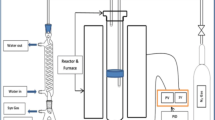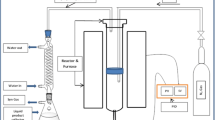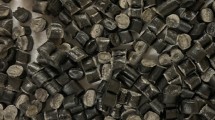Abstract
Pyrolysis is one of the well-known technologies used for bio-oil production, where temperature, heating rate, and nitrogen flow rate are the crucial parameters governing its kinetics. Optimization of design is important for a pyrolyzer to achieve higher bio-oil yield, which necessities the importance of the information such as interactive effects of controlling parameters. Though quite a good number of studies were conducted to analyze the individual impact of these parameters on pyrolysis, their interactive effects have not been addressed well. Also, there are barely any studies investigating such interactive effects using a local grass species Saccharum ravannae, especially in slow pyrolysis. On this perspective, the present study comprises of experiments followed by analysis of data using artificial neural networks. Here, the data obtained from pyrolysis experiments was used to develop a model which can predict the bio-oil yield for a given temperature, nitrogen flow rate, and heating rate. Initially, an experimental program was conducted to study the yield of bio-oil at various temperature regimes, nitrogen flow rates, and heating rates using pyrolyzer. This experimental data was used to train the neural networks, followed by development of an in-house program in C language of trained networks, to predict the yield. Both response surface regression and artificial neural networks (ANN) were used to develop a model and interactive effects of parameters were investigated. An optimum condition of temperature 505 °C with a heating rate of 6.36 °C/min and a nitrogen flow rate of 311 ml/min to obtain maximum yield of 45.69% by wt of bio-oil from Saccharum ravannae was obtained by the optimization analysis of ANN. Regression model has performed better than ANN model. Results of univariate tests show the significant terms in the developed regression equation. From sensitivity analysis, temperature is noted as the highly significant factor contributing to yield followed by nitrogen flow rate.







Similar content being viewed by others
Abbreviations
- S. ravannae :
-
Saccharum ravannae L.
- ANN:
-
Artificial neural networks
- RSM:
-
Response surface methodology
- RSR:
-
Response surface regression
- T:
-
Temperature
- HR:
-
Heating rate
- FR:
-
Nitrogen flow rate
References
Abnisa F, Daud WW, Sahu JN (2011) Optimization and characterization studies on bio-oil production from palm shell by pyrolysis using response surface methodology. Biomass Bioenergy 35(8):3604–3616
Abu El-Rub Z, Bramer EA, Brem G (2004) Review of catalysts for tar elimination in biomass gasification processes. Ind Eng Chem Res 43(22):6911–6919
Ali N, Saleem M, Shahzad K, Hussain S, Chughtai A (2016) Effect of operating parameters on production of bio-oil from fast pyrolysis of maize stalk in bubbling fluidized bed reactor. Pol J Chem Technol 18(3):88–96
Anwar K, Said M, Anwar K, Afizal M, Amin M (2015) Overview on the response surface methodology (RSM) in extraction processes. Journal of Applied Science & Process Engineering (JASPE) 2:8–17
Bordoloi S, Gopal P, Boddu R, Wang Q, Cheng YF, Garg A, Sreedeep S (2019) Soil-biochar-water interactions: role of biochar from Eichhornia crassipes in influencing crack propagation and suction in unsaturated soils. J Clean Prod 210:847–859
Carley KM, Kamneva NY, Reminga J (2004) Response surface methodology (No. CMU-ISRI-04-136). CARNEGIE-MELLON UNIV PITTSBURGH PA SCHOOL OF COMPUTER SCIENCE
Chhiti Y, Salvador S, Commandrè J-M, Broust F (2012) Thermal decomposition of biooil: focus on the products yields under different pyrolysis conditions. Fuel 102:274–281
Chutia RS, Kataki R, Bhaskar T (2013) Thermogavimetric and decomposition kinetic studies of Mesua ferrea L. deoiled cake. Bioresour Technol 139:66–72
Commandrè JM, Lahmidi H, Salvador S (2011) Pyrolysis of wood at high temperature: the influence of experimental parameters on gaseous products. Fuel Process Technol 92:837–844
Demirbas A (2002) Partly chemical analysis of liquid fraction of flash pyrolysis products from biomass in the presence of sodium carbonate. Energy Convers Manag 43:1801–1809
Dhyani V, Bhaskar T (2017) A comprehensive review on the pyrolysis of lignocellulosic biomass. Renew Energy, 1–22
Garg A, Hazra B, Zhu H, Wen Y (2019) A simplified probabilistic analysis of water content and wilting in soil vegetated with non-crop species. CATENA 175:123–131
Gopal P, Bordoloi S, Ratnam R, Lin P, Cai W, Buragohain P, Garg A, Sreedeep S (2019) Investigation of infiltration rate for soil-biochar composites of water hyacinth. Acta Geophys 67:231–246
Günaydın K, Günaydın A (2008) Peak ground acceleration prediction by artificial neural networks for northwestern Turkey. Math Probl Eng, 2008
Isa KM, Daud S, Hamidin N, Ismail K, Saad SA, Kasim FH (2011) Thermo gravimetric analysis and the optimisation of bio-oil yield from fixed-bed pyrolysis of rice husk using response surface methodology (RSM). Ind Crop Prod 33(2):481–487
Jahirul MI, Rasul MG, Chowdhury AA, Ashwath N (2012) Biofuels production through biomass pyrolysis—a technological review. Energies 5(12):4952–5001
Liou TH, Chang FW, Lo JJ (1997) Pyrolysis kinetics of acid-leached rice husk. Am Chem Soc 36:568–573
Li N, Wang X, Bai X, Li Z, Zhang Y (2015) Biomass fast pyrolysis for bio-oil production in a fluidized bed reactor under hot flue atmosphere. Sheng Wu Gong Cheng Xue Bao 31(10):1501–1511
Luo G, Resende F, Murray TA (2014) Bio-oil: an introduction to fast pyrolysis and its applications
Madhu P, Stephen Livingston T, Kanagasabapthy H (2018) Flash pyrolysis of lemon grass (Cymbopogon flexuosus) for bio-oil production in an electrically heated fluidized bed reactor. Waste Biomass Valor 9:1037–1046
Maia AAD, de Morais LC (2016) Kinetic parameters of red pepper waste as biomass to solid biofuel. Bioresour Technol 204:157–163
Maran JP, Sivakumar V, Thirugnanasambandham K, Sridhar R (2013) Artificial neural network and response surface methodology modeling in mass transfer parameters predictions during osmotic dehydration of Carica papaya L. Alex Eng J 52(3):507–516
Mazlan M, Uemura Y, Osman NB, Yusup S (2015) Fast pyrolysis of hardwood residues using a fixed bed drop-type pyrolyzer. Energy Convers Manag 98:208–214
Mohammed IY, Abakr YA, Yusup S, Kazi FK (2017) Valorization of napier grass via intermediate pyrolysis: optimization using response surface methodology and pyrolysis products characterization. J Clean Prod 142:1848–1866
Morf P, Hasler P, Nussbaumer T (2002) Mechanisms and kinetics of homogeneous secondary reactions of tar from continuous pyrolysis of wood chips. Fuel 81:843–853
Onay O (2007) Influence of pyrolysis temperature and heating rate on the production of bio oil and char from safflower seed by pyrolysis, using a well-swept fixed-bed reactor. Fuel Process Technol 88(5):523–531
Park HJ, Park YK, Kim JS (2008) Influence of reaction conditions and the char separation system on the production of bio-oil from radiata pine sawdust by fast pyrolysis. Fuel Process Technol 89(8):797–802
Patel KA, Brahmbhatt PK (2016) A comparative study of the RSM and ANN models for predicting surface roughness in roller burnishing. Procedia Techonology 23:391–397
Paul SC, Panda B, Garg A (2018a) A novel approach in modelling of concrete made with recycled aggregates. Measurement 115:64–72
Paul SC, Panda B, Huang Y, Garg A, Peng X (2018b) An empirical model design for evaluation and estimation of carbonation depth in concrete. Measurement 124:205–210
Paul SC, Panda B, Zhu HH, Garg A (2019) An artificial intelligence model for computing optimum fly ash content for structural-grade concrete. Advances in Civil Engineering Materials 8(1):1–15
Prakash Maran J, Manikandan S (2012) Response surface modeling and optimization of process parameters for aqueous extraction of pigments from prickly pear (Opuntia ficus indica) fruit. Dyes Pigments 95:465–472
Pringle WL, Van Ryswyk AL (1996) Response of reed canarygrass on sedge-organic soil to fertility levels and temperature in the growth room. Can J Plant Sci 47:305–310
Sadaka, S., & Boateng, A. A. (2009). Pyrolysis and bio-oil
Saikia R, Chutia RS, Kataki R, Pant KK (2015) Perennial grass (A. donax L.) as a feedstock for thermo-chemical conversion to energy and materials. Bioresour Technol 188:265–272
Saikia R, Baruah B, Kalita D, Pant KK, Gogoi N, Kataki R (2018) Pyrolysis and kinetic analyses of a perennial grass (Saccharum ravannae L.) from north-east India: optimization through response surface methodology and product characterization. Biosour Technol 253:304–314
Stern F, Muste M, Beninati ML, Eichinger WE (1999) Summary of experimental uncertainty assessment methodology with example (No. 406). IIHR Report
Sunphorka S, Chalermsinsuwan B, Piumsomboon P (2017) Artificial neural network model for the prediction of kinetic parameters of biomass pyrolysis from its constituents. Fuel 193:142–158
Wu W, Mei Y, Zhang L, Ronghou L, Cai J (2015) Kinetics and reaction chemistry of pyrolysis and combustion of tobacco waste. Fuel 156:71–80
Yang H, Yan R, Chen H, Zheng C, Lee DH, Liang DT (2006) In-depth investigation of biomass pyrolysis based on three major components: hemicellulose, cellulose and lignin. Energy Fuel 20:388–393
Zaror CA, Hutchings IS, Pyle DL, Stiles HN, Kandiyoti R (1985) Secondary char formation in the catalytic pyrolysis of biomass. Fuel 64(7):990–994
Zhang Q, Chnag J, Wang T, Xu Y (2007) Review of biomass pyrolysis oil properties and upgrading research. Energy Convers Manag 48:87–92
Author information
Authors and Affiliations
Corresponding author
Additional information
Publisher’s note
Springer Nature remains neutral with regard to jurisdictional claims in published maps and institutional affiliations.
Highlights
• Interactive effects of temperature, nitrogen flow rate, and heating rate on bio-oil yield from Saccharum ravannae.
• Prediction of Saccharum ravannae’s bio-oil yield using trained artificial neural networks and equation (surface response regression).
• Optimization of pyrolyzer conditions for maximum bio-oil yield using Saccharum ravannae.
Electronic supplementary material
ESM 1
(DOCX 17 kb)
Rights and permissions
About this article
Cite this article
Gopal, P., Nadimpalli, G., Saikia, R. et al. Optimization of pyrolyzer design to produce maximum bio-oil from Saccharum ravannae L.: an integrated approach using experimental data and artificial intelligence. Biomass Conv. Bioref. 9, 727–736 (2019). https://doi.org/10.1007/s13399-019-00397-2
Received:
Revised:
Accepted:
Published:
Issue Date:
DOI: https://doi.org/10.1007/s13399-019-00397-2




